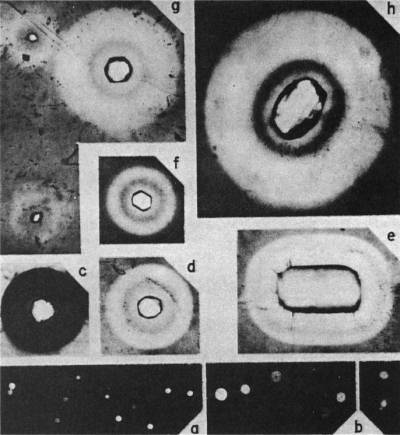|
Earth Science Associates |
|||||||||
|
||||||||||
|
Creation's Tiny Mystery |
||||||||||
|
|
< Prev T of C ... 12 13 14 15 Epi. Cat. App. Ref. Cred. Next > [p. 270]
[p. 271] Uranium and Thorium Radiohalos in MineralsA radioactive halo is generally defined as any type of discolored, radiation-damaged region within a mineral and usually results from either alpha or, more rarely, beta emission from a central radioactive inclusion. When the central inclusions, or radiocenters, are small (1 μm), the U and Th daughter alpha emitters produce a series of discolored concentric spheres, which in thin section appear microscopically as concentric rings whose radii correspond to the ranges of the various alpha emitters in the mineral. Ordinary radiohalos are herein defined as those which initiate with 238U and/or 232Th alpha decay (1), irrespective of whether the actual U or Th halo closely matches the respective idealized alpha decay patterns. In a few instances the match is very good. Compare, for example, the idealized U halo ring pattern in Fig. 1a with the well developed U halos in biotite (Fig. 1f) and fluorite (Fig. 1h,h'); these halos have ring sizes that agree very well (1,2) with the 4He ion accelerator-induced coloration bands in these minerals (see Table 1). In general a halo ring can be assigned to a definite alpha emitter with confidence only when the halo radiocenter is about 1 μm in size. In other cases, however, such as the halos in fluorite (1,2) shown in Fig. 1(g, i-m), much work was required before these halos could be reliably associated with U alpha decay (2). As explained elsewhere (2), reversal effects accompanying extreme radiation damage caused the appearance of rings that could not be associated with definite alpha emitters of the U decay chain. Thus some halos may exhibit a ring structure different from the idealized U and/or Th alpha decay patterns because of reversal effects. And even though most other halos exhibit blurred ring structures due to the large size of the inclusions, nevertheless the outer dimensions allow them to be classified as U and/or Th types. [p. 272] Modern analytical techniques such as Scanning Electron Microscope X Ray Fluoresence (SEMXRF) and Ion Microprobe Mass Spectrometry (IMMA) methods have been utilized to show that U and Th and their respective end-product isotopes of Pb are contained within the U and Th halo radiocenters. As is noted shortly, these modern analytical techniques have proved quite valuable in demonstrating that Po halo radiocenters in minerals contain little or no U or Th, which is in direct contrast to the abundance of these elements detected in the U and/or Th halo radiocenters (2,3).
Doc.: T of C ... #13 #14 #15 #16 #17 #18 #19 #20 #21 ... < Prev T of C ... 12 13 14 15 Epi. Cat. App. Ref. Cred. Next > |
|
|||||||
|
|
||||||||||
|
||||||||||
|
Earth Science Associates
|
||||||||||



